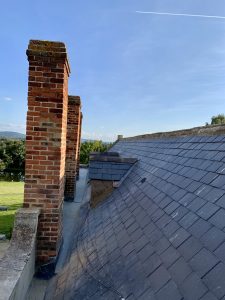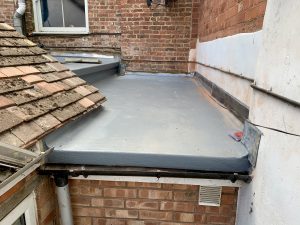What should you choose?
Choosing the right materials to use on your roof can often seem like a never ending battle as each material has its own pros and cons. Take a look at our simple guide to the pros and cons of each different material to help decide what fits with your goal and budget for your next project.
Slates
As one of the oldest and most traditional materials out there, it seems appropriate to start with the variety of types of slate that you could choose for your home. Offering a natural and low maintenance finish, slates are one of the most durable materials you could choose for you home. What’s more, if you’re looking for a classy, stylish finish with little effort, slate rarely looks out of place. With a range of different types out there, it can be difficult to choose between them and the final decision often comes down to the size of your budget.
Natural Slate
These tiles consist of natural stone taken from quarries across the country and each quarry produces a different colour or shape of slate, making yours entirely unique. These slates often contain small  imperfections on them, adding character to your home and giving it a look that can’t be replicated. Your natural slate roof will last you a lifetime thanks to its durability, meaning that although the slightly heftier price tag, it can in some cases be worth it.
imperfections on them, adding character to your home and giving it a look that can’t be replicated. Your natural slate roof will last you a lifetime thanks to its durability, meaning that although the slightly heftier price tag, it can in some cases be worth it.
Artificial slates
These slates are made out of fibre cement, a strong product that can create good quality slates with a smaller price tag. Available in a range of different colours and shades, these slates are often more appropriate for more adventurous architectural projects as they can be applied in a range of different ways.
Although perhaps a more stylish finish, slates can often be more time-consuming to install than other materials, meaning that your overall costs may end up being higher. Additionally, slates are noticeably heavy and cannot be used on lighter roof structures, however they are perhaps more strom-proof than tiled alternatives.
Slates vs Tiles
Clay tiles
Clay tiles are a hugely popular material for many renovations thanks to the wide variety in colours and sizes available. These tiles are quick and easy to install and replace, meaning that if you have a smaller budget, this is the ideal material for you. Although not as long as natural slates, the lifespan of clay tiles can vary between 30 and 70 years, acting as a pretty safe alternative.
Concrete tiles
More budget tiles are made from concrete and are readily available from builders’ merchants across the country, whereas clay tiles are often homemade, rendering them slightly pricier.
Tiles do tend to crack over time, meaning that regular maintenance is key, additionally if you are switching from a different roofing material to tiles, you roof’s support system may need updating thanks to their heavier weight. If you’re desperate for a slate roof but your budget wont quite stretch to it, get the best of both worlds by using roof tiles that look like slates.
Metal roofing
One of the fastest growing materials on the market, metal roofing is a great option if you’re looking for individual shingles made from aluminium, steel or copper, This is appealing thanks to its durability and since is nothing to crack or slip out of place, regular maintenance isn’t necessary, however it does often need to be custom made.
Flat roofs
As specialist flat roofers, this is our area. Flat roofing systems are different to pitched roofs, meaning that slates and tiles aren’t needed to keep your home watertight. Instead, a waterproof membrane is needed to be installed. There are a number of different roofing systems to choose from here so lets go through them…
Felt
Roofing felt is an older, more traditional roofing system that is generally a lot cheaper than its alternatives. With a three layer membrane in most newer felts, modern felt roofing is more sustainable than its former bitumen and stone chip versions, and what’s more, the waterproof polyester membrane ensures that your roof is well protected from the elements whilst providing a substantial level of roof insulation.
Perhaps the cheapest and easiest material to put down, felt is a reliable material that can last around 10 years and after this it is super easy to replace. These membranes are pretty much impenetrable and are great at waterproofing your home on a budget.
GRP Fibreglass
 This is one of our favourite materials to work with and lets tell you why. GRP is far more durable and longer lasting than felt materials and only costs a fraction more. It is easy to apply and can be suited to almost any roof types and sizes so long as there are strong enough foundations.
This is one of our favourite materials to work with and lets tell you why. GRP is far more durable and longer lasting than felt materials and only costs a fraction more. It is easy to apply and can be suited to almost any roof types and sizes so long as there are strong enough foundations.
So which is better? Well this comes down to the scale and type of your job. You see, small outbuildings, sheds and garages will fear well with a cheaper felt roof over the top of them, however for larger projects you should probably consider fibreglass. Both systems are similar in terms of how weather tight they are however thanks to its slightly stronger characteristics, fibreglass may be a better alternative in areas with more extreme weather conditions.
Rubber bond
A hugely popular and cost effective material to opt for, rubber roofing is a great choice for property owners with flat roofs. Used as a weather proofing solution in addition to roofing systems, this material is available in black or white and requires little maintenance other than occasional cleaning and repairs (see our last post for more information on the importance of cleaning your rain gutters).
Rubber roofing vs Roofing felt
This is a far more durable material to its felt counterparts and can withstand some of the most extreme weather. It is also more flexible, reducing the difficulty and therefore costs of repairs when leaks occur. Whilst felt still remains the cheapest material, it is worth weighing up all the options before you make your final decision.
Checkout our projects gallery for more information or if you need a little more inspiration 🙂
